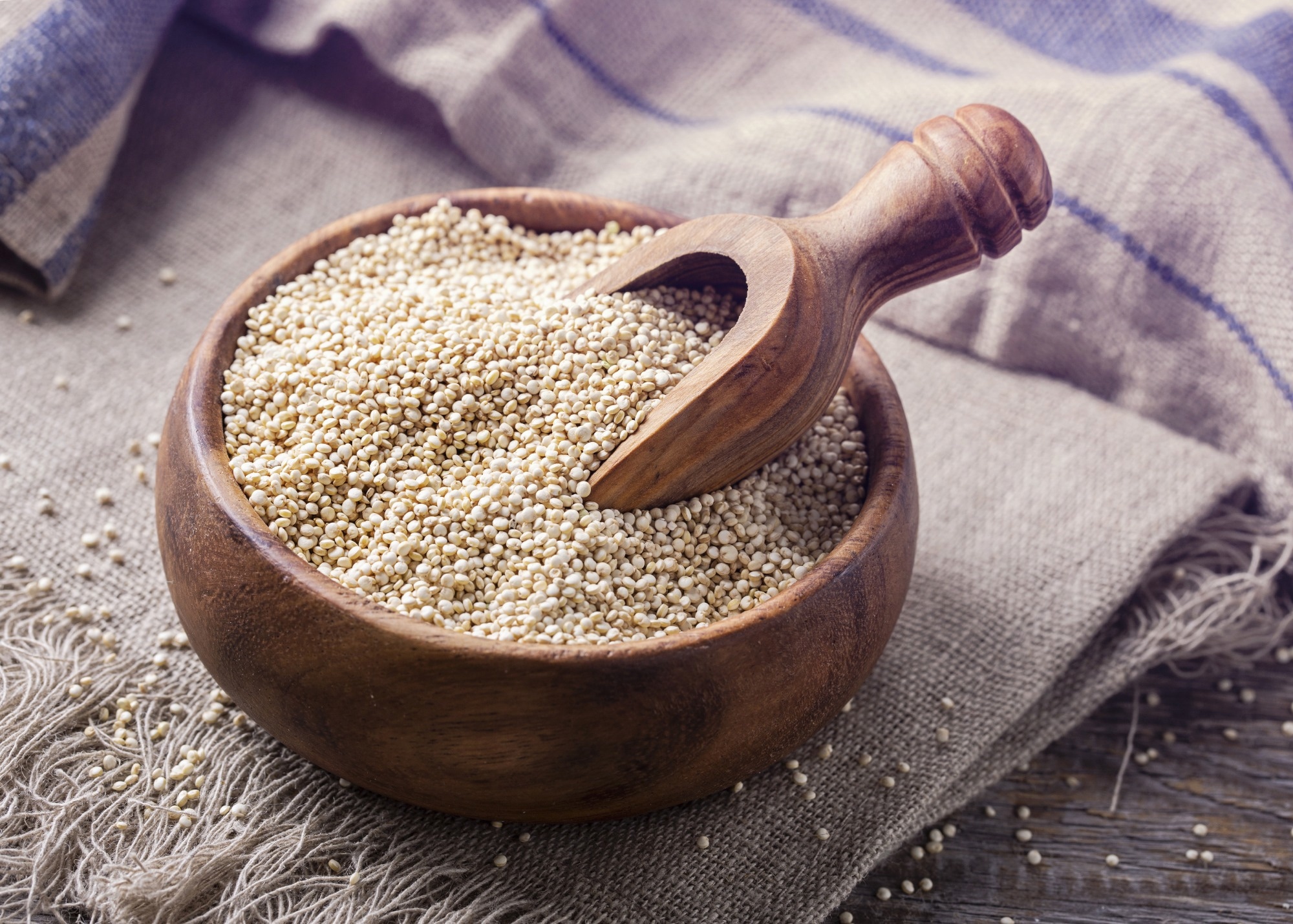In a current overview printed in Vitamins, researchers reviewed present information on the bioactive constituents of quinoa and their well being advantages.
 Research: Biotechnological, Dietary, and Therapeutic Functions of Quinoa (Chenopodium quinoa Willd.) and Its By-Merchandise: A Evaluate of the Previous 5-12 months Findings. Picture Credit score: Elena Schweitzer/Shutterstock.com
Research: Biotechnological, Dietary, and Therapeutic Functions of Quinoa (Chenopodium quinoa Willd.) and Its By-Merchandise: A Evaluate of the Previous 5-12 months Findings. Picture Credit score: Elena Schweitzer/Shutterstock.com
Background
Quinoa, also referred to as Chenopodium quinoa Willd., is a well-liked tremendous crop since it’s winter-hardy, drought-resistant, and simple to develop. Its seeds are ingested as cereal grains and have good dietary content material with very important amino acids, fatty acids, minerals, antioxidants, and nutritional vitamins.
Quinoa seeds are gluten-free and have low glycemic values, making them ideally suited for particular diets and industrial purposes. In addition they possess antiviral, antidepressant, anti-inflammatory, and anticancer results. Quinoa is acceptable for natural and low-input manufacturing strategies.
Quinoa is grown in over 123 nations, and its rising client curiosity and consumption are because of elevated scientific analysis. The depend of quinoa-related articles has practically doubled since 2018; nonetheless, restricted opinions have emphasised quinoa residue worth and sustainability.
Concerning the overview
Within the current overview, researchers investigated the dietary profile and therapeutic properties of quinoa elements and using the grain’s biowaste, prioritizing research printed in 2018.
Bioactive constituents of Quinoa
Quinoa is a processed grain excessive in macronutrients and micronutrients, together with folic acid, thiamine, nutritional vitamins, and bioactive parts resembling phenolic compounds, saponins, phytoecdysteroids, phytosterols, peptides, and betalains.
Quinoa has larger lysine, methionine, cysteine, carbohydrate, protein, and fiber content material than wheat and rice, in addition to larger ash content material.
Quinoa additionally has extra riboflavin and folic acid than different grains, together with oats, wheat, rye, barley, corn, and rice.
The vitamin content material of C. quinoa grain comprises ascorbic acid, alpha-tocopherol, beta-tocopherol, gamma-tocopherol, delta-tocopherol, thiamine, riboflavin, and niacin. 100 grams of quinoa seeds has 40% of the day by day riboflavin requirement for adults and 80% for kids.
Quinoa plant grains are excessive in fats and thus qualify as an oilseed-type crop. The entire content material of lipids ranges between 1.4% and 11%, with polyunsaturated and important fatty acids like linoleic and alpha-linolenic acids being the most typical. Whole proteins additionally range significantly.
Quinoa cookies may also help wholesome people aged 50 to 70 years shed weight and decrease circulating low-density lipoprotein (LDL) ldl cholesterol after 4 weeks of remedy.
These organic actions rely on polyphenols, amino acids, fatty acids, saponins, and fibers.
Potential Advantages of Quinoa for Human Well being
Quinoa extracts embrace important phenolic parts resembling quercetin and kaempferol, which have antibacterial and antioxidant results in vitro.
These chemical substances are highly effective towards micro organism, fungi, and even the fungicide ketoconazole. Quinoa flavonoids, notably quercetin and kaempferol glycosides, are bioavailable and have highly effective antioxidant properties towards free radicals.
Quinoa saponins have quite a lot of actions, together with anticarcinogenic, hypocholesterolemic, antiviral, immunostimulatory, neuroprotective, antifungal, antiparasitic, and anti inflammatory properties.
Quinoa triterpenoid saponins could have hypoglycemic results since they block alpha-glucosidase, improve β-cell exercise, and scale back insulin resistance.
The bioactive peptides in quinoa can regulate L6 cell glucose, probably serving as an antidiabetic drug in spontaneously hypertensive rats.
Moreover, three fractions of quinoa isolate polysaccharides (QP) exhibit dose-dependent immunoregulatory exercise in RAW264.7 cells and antioxidant and antidiabetic exercise in vitro. In vivo, quinoa polysaccharides have demonstrated antiaging properties, reversing D-galactose-induced cognitive impairment in male mice.
Administering 800 mg/kg of quinoa over ten weeks can scale back oxidative stress and lipid peroxidation, enhancing organ operate and restoring lipid metabolism and sirtuin 1 (SIRT1) pathway regulation in rats.
Quinoa seeds include antinutritional components (ANFs), particularly saponins, which may type complexes with ldl cholesterol and different cell membrane parts.
Utilizing raw quinoa seed flour in human vitamin and feed formulation for monogastric animals raises considerations relating to potential gastrointestinal harm.
Quinoa consumption might lead to everlasting alterations resembling meals intolerance, a porous intestine, and dysbiosis. Quinoa seeds ought to be thermally processed to cut back the dangerous results since thermally handled grains have considerably decreased emulsification capabilities and flour dispersibility.
Conclusions
To summarize, quinoa phytochemicals, together with polyphenols, saponins, peptides, polysaccharides, and dietary fibers, have a number of dietary benefits, together with antioxidant, antidiabetic, antiaging, antiangiogenic, immunoregulatory, neuroprotective, antihypertensive, hypocholesterolemic, antibacterial, and antifungal properties.
Thus, researchers can use the bioactive compounds in quinoa to develop numerous medicines to decrease illness burden.
Quinoa waste has a number of biotechnological purposes, together with pure colorants, preservatives, organic therapies, meals dietary supplements, foaming brokers, antibacterial brokers, emulsifiers, and ruminal fungicides.
Its protein isolates have foaming and emulsifying capabilities, whereas its grain flour, aerial parts, leaves, stalk/stem, and seeds are meals parts and industrial compounds.


